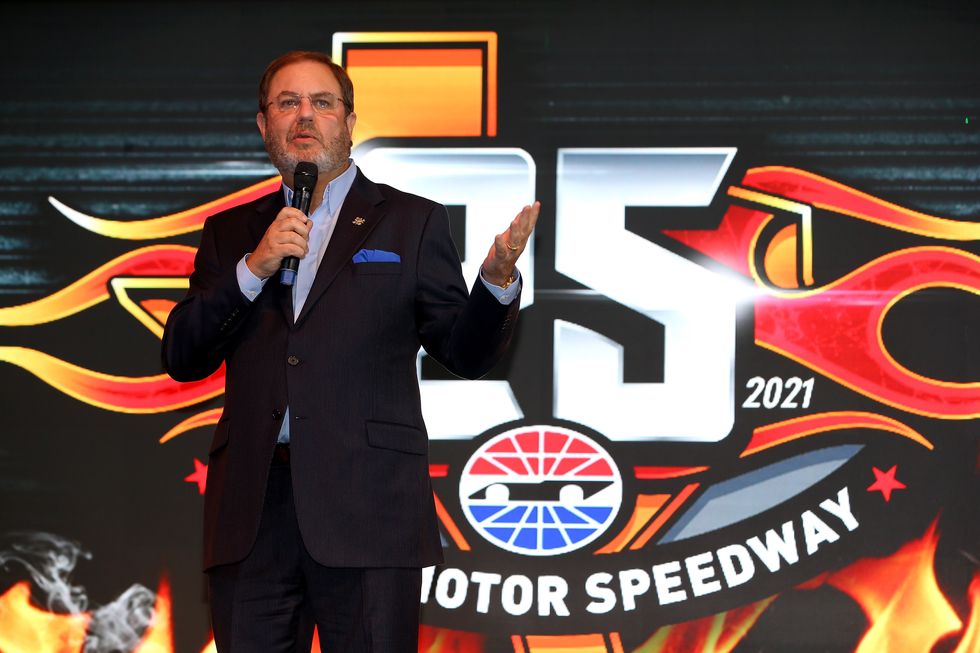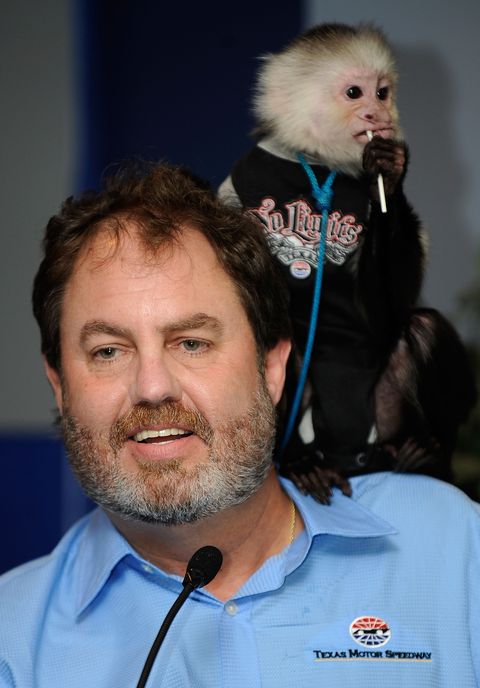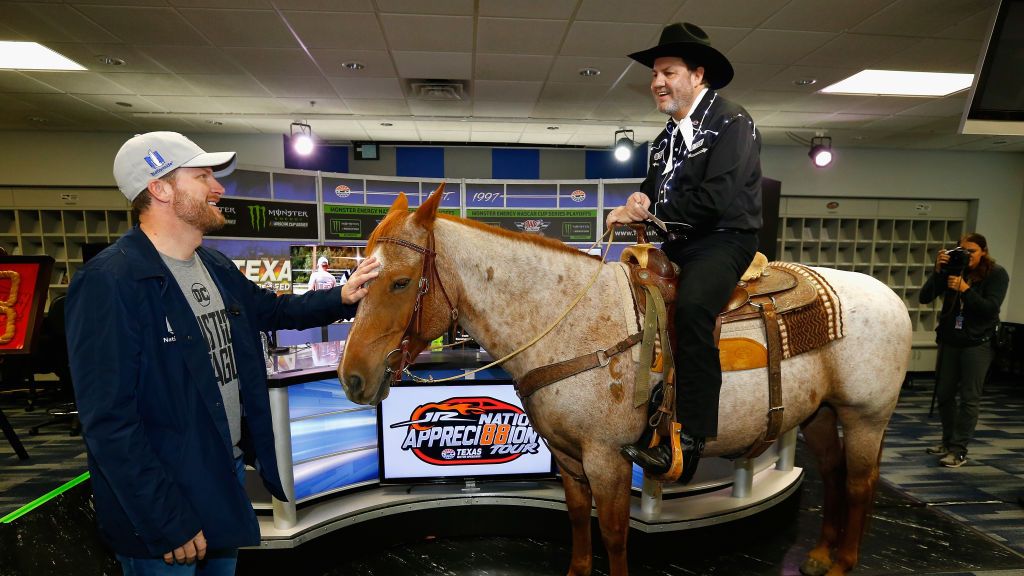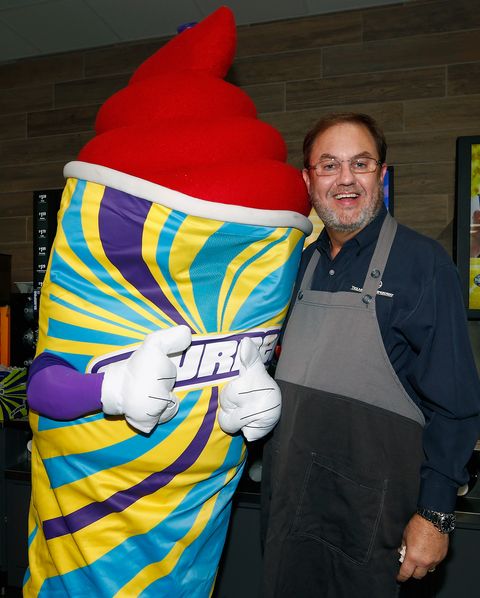- Eddie Gossage wasn’t just the track’s president and GM, he WAS Texas Motor Speedway before stepping down in 2021.
- While Gossage swears he’ll never leave Texas, he is still a very in-demand public and motivational speaker, talking to both racing-related and business groups.
- To this day, TMS holds NASCAR’s single-day attendance record: 221,861 in 1999 and an estimated 223,000 the following year.
After 25 years as its president and general manager, Eddie Gossage walked out of Texas Motor Speedway for the last time following the NASCAR Cup All-Star Race on June 13, 2021 and he’s never looked back.
Gossage’s seemingly abrupt departure shocked any in the motorsports world, most notably NASCAR and IndyCar—both series which had become staples at the 1.5-mile speedway on the outskirts of Fort Worth.
He made it clear that he wasn’t retiring, nor was he stepping down for medical reasons or anything else.
After 25 years at the helm of the good ship TMS, “It was just time,” Gossage told Autoweek in an exclusive interview.
Making the decision to leave TMS wasn’t impromptu. The most significant part of that decision was family: he wanted to spend more time with Melinda, his wife of 24 years, his two adult children and three grandchildren.
And he’s held true to that word, taking his grandchildren—they call ‘em grand babies in Texas—to school almost every day in his beloved pickup truck, and going to virtually every sports event his young’uns take part in.
“It had been a few years coming,” Gossage said of why he left TMS. “I’d been in the sport for 42 seasons … 36 of them I was on the race track side (as well as six years handling motorsports promotion for the Miller Brewing Company).
“It’s just something I had done for a long time and I felt like I had run my course. Probably, as I looked down the road, (I) felt like I would be losing my effectiveness. And I don’t want to do something just for doing it. I felt like I had done everything in my career and I’m one of those guys who loves my wife, my kids and my grandkids and this is one of those deals where I truly wanted to go spend more time with my family.
“Everybody says that kind of thing, but I legitimately spend all day, every day, with my wife and I have a great time doing it. If I’m traveling, she’s with me because I want her with me.”
What’s He Up To?
When asked what he’s doing these days, Gossage, who was never one to shy away from the spotlight when it came to promoting TMS and its events, was almost shy in his response.
“(I’m doing) very boring stuff. I’m a really boring guy,” he said with a laugh. “But I’m actually having the time in my life. I’ve got three grandkids, and we live less than 10 minutes apart.
“I’m a part-time bus driver (a humorous reference to the main use for his pickup truck these days), I go to a lot of their practices for baseball and football and cheer. Cheer is a big thing. And swim meet and swim team practice and all that kind of stuff. That’s most of what I do.
“I still do some public speaking engagements here in the area, but mostly I’m just granddad having the best time. This is the best season of my life.”
After a quarter-century of watching TMS grow into one of the premier facilities in racing, the Nashville native is a true Texan now and he’s not going anywhere else. He’s had overtures for other jobs in other parts of the country, but has turned them all down. Although, if Dallas Cowboys’ owner Jerry Jones came calling, Gossage likely wouldn’t turn Double J down.
Gossage leaving TMS and parent company SMI was such a shock to the industry. He was held in such high esteem by pretty much everybody in the in the racing industry.
“I wanted to give 100% and I always did,” he said. “If anything, I was overcommitted to Texas Motor Speedway, from inception through to my last day. I never want anybody to think that I was kind of mailing it in, so I worked to the last day. And so, everything runs its course with everybody and it was just time.”
The 65-year-old Gossage feels revitalized and reenergized with his slowed-down pace of life, not having to worry about selling hundreds of thousands of tickets to TMS events each year or out-doing his most recent outlandish promotion (our favorite remains Eddie trying to train a Capuchin monkey to sell programs for a NASCAR race in 2010).
Gossage wasn’t just the track’s president and GM, he WAS Texas Motor Speedway. He was there from the beginning, when tabbed by late Speedway Motorsports Inc. CEO Bruton Smith to build the massive facility that would eventually grow to hold more than 180,000 seats (over 200,000 including suites and standing room), the second-largest racetrack capacity in the U.S. behind Indianapolis Motor Speedway.
To this day, TMS holds NASCAR’s single-day attendance record: 221,861 in 1999. The Speedway attracted an estimated 223,000 spectators the following year.
Due to the recession of 2008, a downturn in interest in racing from sports fans and then the whammy of COVID, TMS’ capacity has decreased to about 85,000 seats today. While many of the original seats are currently blocked off, if TMS ever needed a bigger capacity, it’s still there.
Still, Gossage takes great pride in knowing the little old racetrack he built in the cornfields of Fort Worth dwarfs other area sports arenas such as the Cowboys’ AT&T Stadium home, the NBA’s Mavericks American Airlines Arena home and the Rangers’ Globe Life Field baseball park.
“You could fit four and a half AT&T Stadiums in (TMS’s) infield,” Gossage has said countless times, seemingly puffing out his chest at the same time, proving once again that things truly are bigger in Texas.
The Muhammad Ali and Evel Knievel Factor
As he began his career, William Edgar Gossage was heavily influenced in the art of promotion by Muhammad Ali and Evel Knievel. When he joined Speedway Motorsports Inc. in 1989 as VP of public relations for Charlotte Motor Speedway, he proved he was cut from the same cloth and mentored by two of the best, the late Bruton Smith and legendary promoter Humpy Wheeler.
He learned his lessons well, picking Wheeler’s brain for what made successful promotions, and was handpicked by Smith in 1995 to oversee construction of TMS, which included nightly calls with the boss as TMS rose from the ground.
“We’re talking at night and we’d announce (the track would hold) 70,000 seats,” Gossage recalled. “Bruton would say, ‘What do you think? Do you think you could sell 5,000 more?’ I said, ‘Oh, heck yeah.’ And so the next day he’d put in a change order for 5,000 more seats. And then a few days or a week later, he’d say, ‘Do you think you could sell 80 (thousand)?’ I’d say, ‘Oh, piece of cake.’
“And then one day I looked and we were at 155,000 seats and I told Bruton we’ve got to stop doing this. We had dug a big, big hole for ourselves and it’s a two-edged sword in when the sport was strong and healthy, then we were able to sell them out. But once the tide turned in and nobody was really selling the kind of tickets that we’d been selling, then the place looked empty, even though we were still drawing crowds two times bigger than other sold-out Cup speedways were drawing.”
Gossage built TMS into a Taj Mahal of racing, not just for the amenities it included for fans, teams and the media, but also for the promotions, pre- and post-race concerts and other initiatives that added value to the price of a ticket for the average fan. His mantra was to give fans more than they paid for, not less.
Promotions vs. Achievements
When asked what was his most successful promotion, Gossage replied that promotions and achievements were two different things.
“I’ve gotta be honest, I was always thinking about the next one (promotion),” he said. “I never really enjoyed or wallowed in the moment of the promotion that was going on, because there’s always more. It was daily life for me to do the promotion, it was part of getting up and going to work.
“And then for achievements, it’d be selling 200,000-plus tickets over and over and over, drawing the biggest crowds that anybody outside of Indy has drawn for a Cup race and those kinds of things.”
That he left TMS the way he did is equally as confounding as the post-TMS era of his life: since driving out of the infield parking lot in the wee hours of June 14, 2021, he has yet to set foot again back on the track’s property. The track is already on its second GM since Gossage left and he keeps up with track news like most other fans: through the newspaper or radio/TV.
To Gossage, that part of his life is over. It’s on to new challenges. While he swears he’ll never leave Texas, he is still a very in-demand public and motivational speaker, talking to both racing-related and business groups. He admits he’d be interested in a TV gig, preferably NASCAR, which announced a new multi-billion, multi-year deal with several networks and streaming services on Wednesday that goes into effect in 2025.
“I think I’d consider it because I am young yet,” Gossage said. “The truth is, I wouldn’t consider moving because I like being less than 10 minutes from my grandkids. That’s really important. But if there was a project, maybe. If it was a TV deal, where you’re traveling on weekends here and there, maybe. But would I go run a race track in whatever city? I don’t think that will ever happen.”
All of his time at TMS was not fun and games. There was controversy at times and some promotions didn’t go as well as he hoped. Then, right around his birthday in October 2008, Gossage learned he had cancer. He fought it like Ali fought Joe Frazier and a year later, he was in total remission, and six months after that he revealed he was cancer-free.
When he left TMS, Gossage was praised by many for what he achieved in his colorful career. Perhaps the best epitaph came from Larry Woody, former sports columnist for The Tennessean newspaper, who was instrumental in getting Gossage his first job at a race track, Nashville International Speedway.
Of Gossage’s departure, Woody wrote in the Main Street Nashville website: “The sport won’t be nearly as much fun.”
Follow Autoweek contributor Jerry Bonkowski on Twitter/X @JerryBonkowski
Read the full article here






